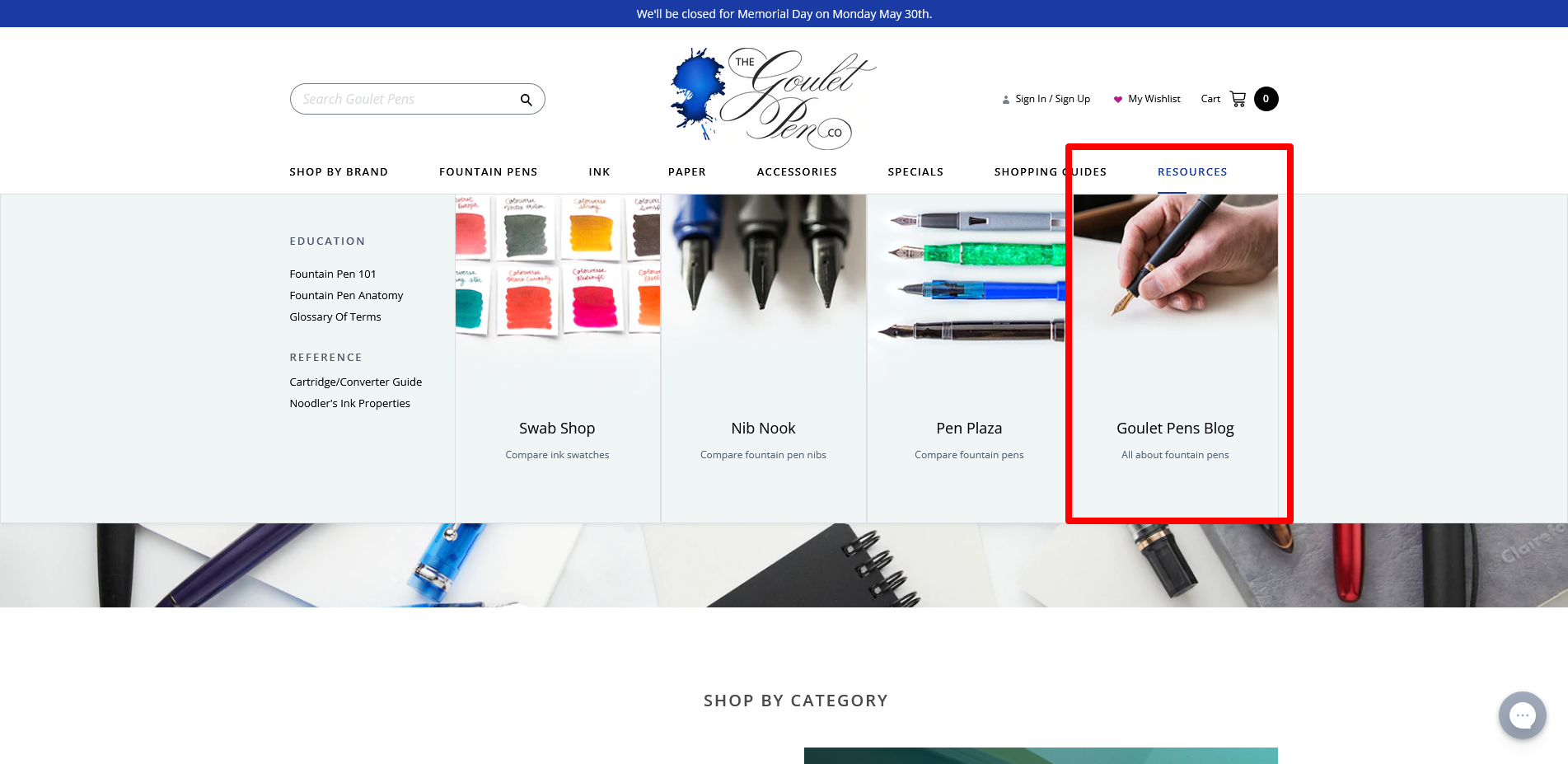Ecommerce Blogs: WordPress Subdomain vs Shopify Blog
Content marketing is central to the success of most growing online businesses. And central to content marketing is blogging.
Put simply, your Shopify store should have a blog to inform and educate your visitors about your niche area and to generate more leads from search.
But how should you set up your blog?
For most Shopify store owners, it will come down to a straight choice: WordPress subdomain vs Shopify blog.
Here we look at what each one provides, and the pros and cons of each.

Why should ecommerce stores set up a blog?
Don’t underestimate the power of a blog and its potential to drive traffic and potential customers to your store.
Regardless of what you sell, someone is searching online right now for more information, the latest news, and opinion on what’s best in your product niche. Your content helps answer those questions and can get you ranking highly in the search engine results pages (SERPs).
For instance, the supplement provider Bulletproof, a Shopify client, writes posts on supplements and nutrients, educating its audience and answering their main questions with detailed, long-form content like this:

When you search for what to look for in a greens powder supplement on Google, this is what the top of the page looks like:

The blog content that Bulletproof has written features directly at the top of the search engine results page in the most prominent position possible (it’s called “position zero” or the “featured snippet”).
So, by directly answering a question that its target clients search for, Bulletproof’s post can generate a large volume of click-through traffic to read it. Once readers are in the store, guess what? They look around and maybe buy there and then — or add the store to their watch list for next time.
Either way, blogging is good for business and ecommerce stores should get on board with developing interesting, informative and original content like this to reap the benefits.
Now, how do you do that?
Should you run a blog off your Shopify website, using the in-built blogging platform or use a WordPress blog hosted on a subdomain of your primary hosting (so it appears as a seamless attachment to your store)?
Let’s break it down into a few categories and see how they compare:
WordPress vs Shopify blog: Which is easier to set up?
Shopify makes it very simple to set up a blog using its inbuilt platform.
After logging in to your Shopify admin console and clicking on Online Store, you click on Blog posts and then the Create blog post button, like this:

When you click on Create blog post, you get taken to a page to start writing your blog post in a WYSIWYG editor (no HTML knowledge needed) like this:

With Shopify, it couldn’t be easier. No domain adjustments are required as it uses a sub-folder system on the main site. It may take a little time to get your posts looking how you want them to with the right design, images, headers and so on but basically anyone can do it.
With WordPress, there are a few more hoops to jump through.
You will need a WordPress blog hosted with its server somewhere. We recommend WPX. Then you will need to contact the domain registrar to get a subdomain of your main domain setup to point at the WordPress hosting IP address:
- myshopifystore.com may point to your Shopify store.
- blog.myshopifystore.com may point to your WordPress blog.
You will also need to add a Blog menu item in your Shopify store settings and link to the blog so that visitors to your website can access it from the main menu on every page, like this:

In fact it’s best to copy the whole header and footer of your Shopify store to the WordPress blog for UX. Although from an SEO perspective its best to leave the blog as only a blog. As Google likes to make it hard to rank collection and product pages, because they want you to pay for Google Shopping ads.


WordPress vs Shopify blog: Which is better for search?
Improving performance in search is a big reason for investing time and money into a blog, so this is a key factor to assess for Shopify and WordPress.
Search engine optimization (SEO) is complex and many ranking factors go into successful search performance. Backlinko names 200 ranking factors for Google.
As far as WordPress vs Shopify blogs go, the SEO advantage is with WordPress.
- Page-load speed affects SEO and user experience, especially for mobile users. WordPress outperforms Shopify for speed as you have more control over the server, server type (Eg Apache etc), caching, CDNs and more.
- People believe the Shopify subfolder blog will perform better than one on a subdomain like WordPress, in fact due to your inability to change the URL structure in Shopify WordPress ranks better. This is because the Shopify blog URL depth is 3 layers deep which is not recommended by Google. Eg bhoma.com/blogs/jewelry-blog/types-of-bracelets/ Whereas WordPress is just blog.bhoma.com/types-of-bracelets/

Both Shopify and WordPress allow you to look after the on-page optimization of your blog posts relatively easily, adding title, meta descriptions, and optimizing keyword usage but it is mainly the overall quality of your content, backlinks and usability signals that will dictate search rankings.
WordPress is far better for SEO due to the URL structure of Shopify blogs its really
WordPress vs Shopify blog: Which is better for branding?
How well your blog fits in with your overall branding is another factor that may influence your decision.
How do WordPress and Shopify blogs compare for design and branding? When potential customers arrives on your blog, do they associate the content immediately with you and your store?
Both WordPress and Shopify offer a variety of themes for your blog.

WordPress offers thousands of eye-catching designs for your blog. Shopify is more restrictive in this respect but there are still plenty to choose from and this should certainly not be a deal-breaker.
Besides, the blog that’s built into the store shares the theme with the store so it retains the same look and feel, which provides consistency for your brand. If you change your store theme, the design of your blog changes with it. This is important in developing trust with customers, who want to be sure they are dealing with the same brand. And trust equates to sales, as we know.
If you use WordPress, you will need to play around quite a bit more to develop a consistent look and feel and make your blog appear as an extension of your main store. It can be done, it’s just not as automatic as with a Shopify blog. You may need the help of a developer or at least someone with good technical design skills.
Ultimately, the themes on offer from both Shopify and WordPress will be adequate for most stores but, if not, a developer can help you custom-design what you need for either platform.
WordPress vs Shopify blog: Which is more flexible?
When it comes to flexibility and adaptability, WordPress may win the day over Shopify.
One thing to be aware of is that Google changes its policies and algorithms regularly so search performance can rise or fall according to the prevailing thinking. Many sites have experienced rapid “overnight:” falls from grace due to a change of Google’s algorithm.
When this happens, as it inevitably will again, it pays to have a flexible blog that can adapt quickly to the changes. We cannot predict where Google will take its algorithm but by focusing on high-quality, informative content, you can’t go far wrong.
In recent years, Google added “rich snippets” and “People may also ask” sections to its results pages, for instance — which has caused many blogs to change their approach.
Say that Google started to reward posts of 2,000 words or more or gave priority to posts that included video. You may need to adjust your blogging approach to retain good rankings.
Shopify keeps a fairly tight control on what you can and can’t do with your blog. It is less flexible than WordPress in this respect. WordPress has a huge ecosystem of almost 60,000 plugins, including thousands that relate to blogs. These expand functionality and allow extra flexibility. You can also ACF or Advanced Custom Fields in WordPress to control the blog meta data however you want.

The Shopify app store has plenty of blog apps but much fewer relating directly to blogs than WordPress. It’s something you might bear in mind when comparing WordPress vs Shopify blogs.
Certain features that you might like to add to your blog posts are easier with WordPress than Shopify because of the extra plugins to add to these features — including comments section functionality and adding a table of contents.
These rather basic requirements are more difficult with a Shopify blog as they are not part of its native functionality. You may have to add a table of contents manually (with internal linking) or hire a developer if you can’t find a suitable app to look after the task, for instance.
Conclusion: WordPress or Shopify blog?
Ultimately due to the SEO URL structure of Shopify blogs, serious stores focused on SEO have no option but to use WordPress as a subdomain blog. We’ve tested this with our own stores like Bhoma.com and it’s much easier to rank even with building a new backlink profile for the WordPress subdomain. If Shopify changes the blog to allow a different URL structure, then we will revise our position.
